
This guy might benefit from a little experimentation with positioning pillows.
There’s a large market of sleep products called positioning pillows. Positioning pillows do exactly as their name implies. They help to hold your body in whatever position is deemed comfortable and/or beneficial to sleep. Most of these products are made from polyurethane or polyester foam. They are generally covered with a simple bleached cotton shell.
There are hundreds of different designs. Some are wedge shaped and are designed to elevate your torso slightly and others are cylindrical for elevating your knees. Many unique configurations are available, each designed for a specific purpose. You can’t rest our head on too many positioning pillow types-their odd shapes won’t conform to your neck and head.
Being every product so unique, it can be hard to find the one that works well for you. Thus it’s helpful to purchase a multi-use product; something that’s designed for different use scenarios. Experimentation is key when it comes to sleep position. Something versatile will allow you to try different positions and discover what works best for you.
The Ultimate Positioning Pillows?
Is there a catch-all perfect product? Unfortunately no, but we think buckwheat pillows work very well for most contexts. The buckwheat hull fill consists of thousands of hulls with irregular edges that grip each other. This unique characteristic of the buckwheat hulls makes it ideal for use as fill. It allows the pillow will hold and retain its shape, which is fantastic for use as a traditional pillow, but also works exceptionally well as a positioning pillow.
Use one or more buckwheat pillows to:
- support your upper body at an angle for reading or sleeping.
- elevate your knees for reduction of lower back pain or leg swelling.
- provide lateral support to prevent you from rolling over (this can be a very useful tip for when learning to sleep on your back).
Buckwheat pillows are a terrific natural alternative to the many expensive specialized positioning pillows for sale today. If you’re in the market for one, give a buckwheat pillow a try and if it doesn’t work specifically as a positioning pillow, toss it under your head!

If you’re able to sleep on your back, you’re one of the few. Only 14% of us sleep this way.
What’s so great about sleeping on your back?
Back sleeping can help to reduce back and neck pain, minimize the effects of acid reflux, decrease wrinkles, and even help to maintain perky breasts!
While back sleeping can exacerbate snoring issues for some and isn’t recommended during pregnancy, it’s considered by many experts to be the healthiest way to sleep. Sleeping this way makes it easy for your head, neck, and spine to maintain what’s called a neutral sleeping position; they’re in near ideal alignment when lying on a flat surface.
Back sleeping is great — if you can pull it off.
It’s possible to learn how to sleep on your back, but it’s not easy for everyone.
Generally I sleep on my side, but lately I’ve found myself occasionally waking up on my stomach. I’ve started to develop a few random aches and pains, mostly in my back, and I worry that it may have something to do with my sleeping habits.
Thus, I recently decided to try sleeping on my back. I did some research and, armed with a few tips I discovered online, I committed to a best effort attempt at healthy back sleeping!
How Train Yourself to Sleep on your Back–First a Few Tips:
- Use positioning pillows. Extra pillows in the bed can help to keep your body positioned in whatever specific way works best for you. A pillow under each arm is a preferred technique, but do whatever works for you.
- Keep a pillow under your knees to help maintain proper alignment of your back. This can help if you’re experiencing any lower back discomfort.
- Be persistent. Always roll to your back when you catch yourself positioned otherwise.
- Use a pillow that will hold your head in place. What’s the best pillow for back sleepers? A malleable type like a buckwheat pillow works well. It will prevent your head from rolling from side to side and give you the best support.
My back sleeping experience…
I already have a great pillow. I love it—a buckwheat pillow. Most often, I sleep on my side, so it’s stuffed pretty full, with about 8 lb. of buckwheat hulls. I removed some of the fill to make it flatter, making it more conducive to back sleeping (when on your back there’s a much smaller space to fill between your head and the mattress).
“This will be no problem.”
My first night on my back was a total failure. I was exhausted and gave up after just a few minutes.
“Why can’t I sleep on my back?” I asked myself.
I shrugged and gave up for the night. So much for best efforts…
The following day at bedtime, I laid on my back reading and within about a half hour my lower back became slightly uncomfortable. Initially it wasn’t anything resembling pain. It wasn’t something I’d have noticed under normal circumstances-typically I’d just roll over to my side and the discomfort would immediately disappear. I resisted the urge to do so. Soon the slight discomfort became a dull ache. It wasn’t working. I pulled out another pillow and placed it under my legs. Still, it persisted. I gave up and fell asleep on my side.
Apparently stretching your hip flexors before you get into bed at night helps to eliminate lower back pain. I tried that. I’m not sure if it helped or not.
It was more or less the same struggle for the next few days.
To make any real progress, I had to experiment a lot with the pillows. I found that the pillow I used under my legs was initially a little too small and didn’t elevate them high enough to prevent the discomfort I was feeling in my lower back. I’m using a larger pillow now which has completely resolved that issue. To prevent myself from rolling over, I’m using a buckwheat pillow under each arm. This really helps to keep me anchored to my back (it’s also surprisingly comfortable).
Finally after 5 days of trying, I fell asleep on my back. Of course I woke up in the morning on my side, so there’s no telling how long I managed to stay in that position. My guess is not long. However, I feel like that was progress and I’ll keep trying.
The most important of the tips listed above is be persistent.
I found it incredibly difficult at first to resist the urge to roll onto my side. It’s hard to think rationally when you’re exhausted! It took a whole week just to get to the point where I could fall asleep on my back.
I’m still not a back sleeper and to be honest I’m not sure I can do it. I’m going to continue, but I’m not sure if this is a something that I can turn into a habit.
Try my recommendations and let us know your experience in the comments below.
(Edit 6/29/19) Why I can’t sleep on my back!
Back sleeping has genuine benefits, but it isn’t going to work for everyone.
I tried. I was persistent. But, in the end, I just wasn’t getting the same rest as I was while on my side.
For the moment, I’m OK with the mild discomfort associated with my somewhat haphazard side and stomach sleeping position(s). I might try again if the discomfort becomes something worse.
Sleeping on one’s back isn’t going to be ideal for everyone. So, after giving it a solid effort, be prepared to return to your old habits if that’s what works best.

The next time you check into a hotel, ask if they have buckwheat pillows on their pillow menu.
Hotels and resorts around the world are adding pillow menus as a way to cater to individual needs and indulge their guests. This is great news for those of us who sleep on unique pillow types like buckwheat pillows. It’s a also a great opportunity for those interested in trying a new type of pillow. Hotel pillow menus are usually free of charge and include several options.
Common Pillow Types on a Typical Hotel Pillow Menu
- Aromatic Pillow: pillows infused with herbs, potpourri, oils or other aromatic ingredients that can have soothing and calming effects on the nerves and rejuvenate the senses. Some sleep inducing ingredients you may find in an aromatic pillow are hops, chamomile, valerian, skullcap, and lavender which can help promote restful sleep.
- Body Pillow: body pillows are as long as a full adult body, providing support to the head and neck at the top and to the knees and legs lower down. This type of pillow can be especially useful in providing support for those who sleep on their sides and for pregnant women.
- Buckwheat Pillow: popular throughout asia and filled with buckwheat hulls, this natural pillow conforms to the shape of your head and neck and stays cool all night. Many buckwheat pillows are designed with a zipper that allow you to add or remove hulls and adjust the pillow to your desired thickness.
- Microbead Pillow: based on traditional buckwheat pillows, these pillows are filled with over 10 million synthetic microbeads or “air beads.” The microbeads allow for air circulation which can help keep the pillow cool. Mircobead pillows are an ergonomically designed, contoured pillow with a crescent shape.
- Down or Feather Pillow: these are the most common pillows you will find at a hotel. Filled with feathers from the back, wing, and chests of geese and ducks, down pillows are typically very plush, soft and warm.
- Maternity Pillow: usually wedges or full body pillows that support the belly and lower back, while helping to align the hips, all with the goal of alleviating the stress of pregnancy.
- Memory Foam Pillow: developed by NASA as an aircraft cushion, this polyurethane foam is pressure-sensitive and molds quickly to the shape of a body pressing against it, returning to its original shape once the pressure is removed. When new, some memory foam pillows give off a distinct chemical odor so you may want to check it out before committing to sleep on one all night.
- Music or Sound Pillow: can allow users to enjoy their favorite music or sounds in optimal relaxation and comfort. High quality stereo sound comes from two virtually undetectable speakers with a plug that fits most modern audio/electronic devices. Some sound pillows come with mp3 players pre-loaded with relaxing soundscapes that can help relax the brain and body so you can easily fall asleep and stay asleep throughout the night.
The next time you make a reservation online or check-in to a hotel look for a pillow menu. If you want a pillow that’s not synthetic or animal fill, don’t be afraid to ask for an all natural alternative. When available, we recommend a quality buckwheat pillow.

Maybe she should turn on the air conditioner.
In the middle of the summer’s sweltering heat, you climb into your comfortable bed. The temperature in your room is set just right – not too hot, not too cold. You slowly drift off to a deep sleep only to be rudely awoken later in the night, in warm, sweaty bedding.
Unfortunately some of the most popular pillows types containing down or memory foam retain your body heat while you sleep making them uncomfortably hot.
Many people simply crank up their air conditioner. It’s far from a good solution. Cooling a home costs the average American household about $375 or 17% of its annual energy bill.
How to stay cool in bed? Many cool sleep solutions are available, but not all are effective.
You can flip your pillow over to the cool side all night long, but it will always build up and retain heat. Down, feather, polyester and foam pillows all suffer from this same problem. In fact, these types of pillows aren’t very breathable. Thus, the fill restricts airflow within the pillow. The temperature of the air that’s trapped inside rises, turning your pillow into a little oven.
There are some interesting solutions for a hot pillow out there: some use mysterious fabrics, others liquid cooling gels or refrigerated pads. These all address the issue with varying degrees of success. Most however, do not address the important issue of breathability.

A breathable pillow is a cool pillow.
It’s simple: a breathable pillow is a cool pillow.
If air is able to pass through your pillow while you sleep, it will not retain or build up the heat generated by your body. Most of the “cool pillows” available do not allow air to move through the fill with any more ease than a traditional one.

Beautiful buckwheat hulls: Hullo™ buckwheat pillow’s contents are revealed.
The simplest way to stay cool in bed is with a buckwheat pillow.
Buckwheat pillows are filled with thousands of tiny buckwheat hulls. These are the by-product of milling the buckwheat plant for its nutritious groats (most commonly used to produce soba noodles). The hulls’ hollow, irregular shape allows warm air to quickly escape your pillow, while being replaced with cool fresh air.
Buckwheat’s cooling ability is a result of its breathability:
- Moisture collects on your skin and inside your pillow while you sleep. The unique shape of the individual buckwheat hulls inside the pillow allows air to flow more freely through the pillow, increasing evaporation of that moisture. The evaporation produces a cooling effect similar to a fan’s.
- Buckwheat hull fill allows warm humid air absorbed from your body to quickly escape the pillow, in effect preventing uncomfortable heat build-up.
Buckwheat pillows aren’t just cool, they provide terrific support for your head and neck. The buckwheat hulls’ unique character gives them the ability to shift and conform perfectly to the shape of your body. As a result, the weight of your head to be evenly distributed, preventing any undue stress on the muscles in your neck and back.
I recommend our own Hullo buckwheat pillow. Don’t take my word for it—check out these reviews from our customers.
Read More: Does That “Cooling Pillow” Really Work? I Tried Four.
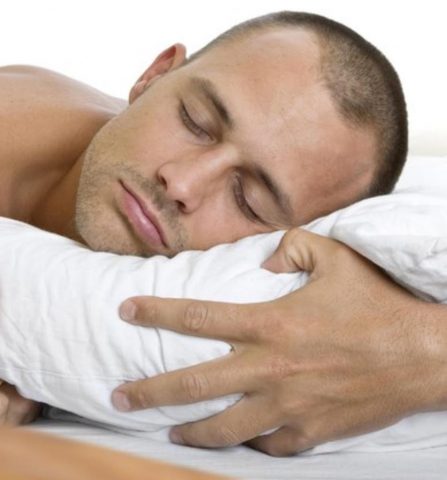
Experts say this poor stomach sleeper’s breasts will sag prematurely.
Are you among the 16% of Americans that sleeps on your stomach? Most sleep experts will tell you to try acclimating to another sleep position.
Sleeping on your stomach can cause your head, neck and back to be pushed upward at an uncomfortable angle. In addition, you’ll have to keep your head to one side or the other all night (breathing into your pillow is no fun, after all). The unnatural positions your head, neck and back are contorted into can cause aches and pains, particularly as we age.
Sleeping on your stomach can even cause wrinkles and saggy breasts!
While on your stomach, it’s very difficult to maintain a neutral sleeping position that allows your spine and neck to be aligned.
Your spine is best off when it’s straight. It’s simple: bends and twists in your back can cause muscle strains and put pressure on nerves. Keep your back straight and you’ll avoid back pain.
Unfortunately, stomach sleeping causes increased pressure on joints and muscles which can cause uneccessary soreness or numbness.
First and most obviously, you should at least try to sleep in another position if you can. That’s easier said than done of course! We sleep the way we do because that’s what is comfortable. If you’re content on your stomach, then make the most it.
What Can a Stomach Sleeper Do to Get Better Rest?
A very simple technique that works for some: try sleeping with no pillow at all. This will achieve something close to a neutral sleeping position, helping to keep your spine parallel to the mattress.
If that doesn’t feel right (and to most it will not), then you’ll want to find a low loft (thin) pillow that doesn’t elevate your head too high. Some pillow manufacturers have specially designed low loft stomach sleeper pillows. Most of these are quite simply thin pillows, but some others offer wild features like special arm tunnels.
What’s the Best Stomach Sleeper Pillow?
Most pillows are simply too thick for a stomach sleeper. Your best bet is always going to be a thinner, low loft pillow type. An adjustable pillow with a zippered opening that allows its fill to be added or removed will give you the ability to fine tune it to your preferences.
Being that your exhaled breath is directed downward toward your pillow, it’s helpful to use a pillow type that doesn’t retain heat. Most traditional pillow fill can get pretty toasty if you’re blowing hot air into it all night.
No single pillow works for everyone. Squeezing a pillow inside plastic packaging at the store isn’t the way to find the right one. You need to test drive them in your own bed. Check the manufacturer’s return policy and make sure that you’re able to try it for at least a week. If it’s not right for you, toss it back in the box and return it. You spend a third of your life with your head resting on a pillow, so a little shopping and experimentation is absolutely worth it.
We of course, recommend buckwheat pillows for stomach sleepers.
They’re malleable, adjustable and stay cool thanks to their unique fill. Other decent alternatives are:
Buckwheat, millet and kapok pillows are often sold with zippered openings, while down pillow cases are always sealed. Being that a down pillow’s fill is not adjustable, be sure to shop specifically for low loft variations.
If you’re content to stay on your stomach, first try sleeping with no pillow at all and if that doesn’t work out, do some deliberate and careful shopping for a new pillow. The best stomach sleeper pillow will provide you sufficient support for both your head and neck without elevating them too high. Above all, it’ll simply be comfortable.
Read more: Sleeping Position and Buckwheat Pillows
Read more: Sleeping on Your Stomach: Make the Most of It!
Contour pillows made of synthetic foam are not adjustable. They cannot accommodate every body shape and sleeping position. This is just one of several reasons why you should consider sleeping on a buckwheat pillow – the best contour pillow.
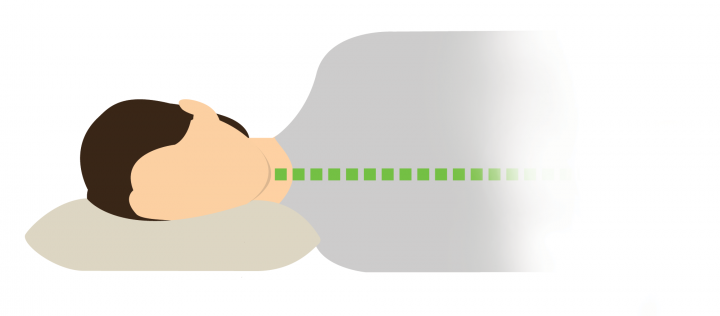
A buckwheat pillow reshapes and resizes to fit both your body and your sleeping positions.
About Contour Pillows
“Contour pillows” or support pillows are orthopedic pillows designed to keep your neck and spine in alignment while providing comfortable and healthy rest. These pillows are typically made of synthetic foam, and more recently memory foam has become popular. Memory foam pillows are made of a heat-sensitive foam which accquires the shape of the body sleeping on it.
Contour pillows can be effective at promoting comfort and restful sleep. Some claim to provide relief of various medical conditions including neck pain, sleep apena, snoring, lower back pain, and insomnia. While contour pillows can be comfortable, synthetic foam pillows do come with some disadvantages.
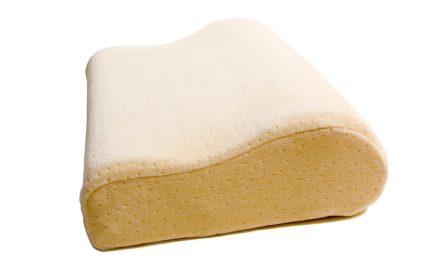
A typical memory foam contour pillow. Is your body really always shaped like this?
Foam Contour Pillows Are Not Adjustable
One of the biggest problems with foam and memory foam pillows is that they come in a predefined geometric shape. Foam will collapse and conform to you head somewhat, but it cannot be shaped, plumped or molded to support a wide variety of sleeping positions. Many people change positions throughout the night and a preformed foam pillow is not shaped optimally for many of these positions. You typically can not adjust the pillow thickness of a foam pillow. Depending on your body shape, the firmness of your mattress and your sleeping positions, a foam pillow may be too thick or too thin for maximum comfort and health.
High-quality buckwheat pillows generally have a zipper. A zipper enables adjustment of the amount of filling in the pillow. You can change the thickness of your pillow to be customized for maximum comfort by adding or removing buckwheat hulls. A buckwheat pillow can then be shaped to a range of shapes and sizes as you sleep to provide superior support and comfort.
Buckwheat Pillows Are Breathable
The irregular and hollow shape of buckwheat hulls creates airspace within your pillow. This airspace enables free air circulation and breathability. This results in a cool, dry pillow, for that “cool side of the pillow” effect all night long.
Buckwheat Pillows Are Made from Natural Renewable Materials
Many popular pillow types contain polyurethane or polyester foam that can emit toxins and carcinogens that aren’t good for you or our environment. There’s no sense in risking your health or filling our landfills with potentially toxic waste!
Buckwheat pillows are safe for your family and the environment. Buckwheat crops benefit little from chemical fertilizers, thus it is free of many of the contaminants that are present in other crop types. The hulls are compostable, which helps to reduce unnecessary waste in our landfills and keeps our soil healthy and nutrient rich for future generations. Additionally, buckwheat pillows contain no animal products for those interested in a vegan lifestyle.
Buckwheat Pillows Have the Highest Satisfaction Rating
The all-natural, adjustable and cool comfort of a buckwheat pillow is the best alternative to traditional contour pillows. Many people do not give their choice of pillow a second thought and as a result, they are likely missing out on better rest.
You can read our buckwheat pillow reviews for an idea of how much people love their buckwheat pillows.
Read More: “That Weird-Looking Neck Support Pillow”
“If people were meant to pop out of bed, we’d all sleep in toasters.”
-Author unknown
We were happy to get a little publicity this week. Paul Lundgren of perfectduluthday.com and Barbara Reyelts of Northland’s News Center present the Hullo buckwheat pillow on the program “Northland Voices”.
Thanks Paul and Barbara!

In a few years this mother will lie on her buckwheat pillow and dream of her teenage daughter’s once pleasant demeanor.
We recommend you try our own Hullo pillow, but if you are interested in how to make your own buckwheat pillow, read on…
A quality buckwheat pillow consists of the fabric case, a zipper, and of course, the magical buckwheat hull filling.
You can expect a buckwheat pillow to last several years with proper care, so think twice before you purchase any inferior materials. It can be worth a few extra dollars for superior components if it means that it’ll last a few years longer.
First you should determine what size pillow you want to make. The most popular sizes of buckwheat pillow are 14×20 and 20×26.
Buckwheat hulls are much heavier than down or foam fills — a standard sized buckwheat pillow can weigh up to 9 pounds. For that reason, you’ll need to take this extra weight into consideration when selecting your fabric. Don’t get fabric that’s too thin, or it’ll tear or wear out quickly. For a standard size pillow, use a medium weight fabric (5-7 oz. per yard), while a smaller japanese-style pillow could use something as light as 3-4 oz. per yard).
You’ll cover your pillow with a standard pillowcase, so be sure to pick an unassuming fabric that won’t clash with the pillowcase you put over it. As for the zipper, you should choose something that’s strong enough to support the full weight of the pillow in its teeth. A cheap skinny zipper that won’t stay latched under pressure will cause lots of headaches when it lets buckwheat hulls loose all over your bed.
How to Make Your Own Buckwheat Pillow
We’ve included these two YouTube links that demonstrate simple techniques for sewing the shell and zipper:
Now for the final ingredient, buckwheat hulls… A standard-sized pillow will require around 7-9 lbs of buckwheat hulls and for a japanese-style pillow about half that. Try this pillow fill calculator to help you choose the correct amount of buckwheat hulls for your pillow.
There are a lot of different varieties of buckwheat, some better than others for use in pillows. In addition, different milling processes can crush or flatten the hulls, which negates their primary benefits, malleability and breathability. It’s hard to know if you’re getting mulch-grade or premium pillow-quality without seeing them firsthand.
After a lot of detailed research, we are able to offer what we believe are the best quality pillow-grade buckwheat hulls available online. We believe you’ll find our buckwheat hulls exceptional and offer a 60 day return policy.
Fill it up and experiment with the amount of fill, it can make a big difference in how it feels. Enjoy!
When you first open the zipper of your pillow to access the pillow filling, you’ll notice the buckwheat hulls are light and airy. The thought of adjusting the hulls without making a mess can be intimidating but the process is really quite easy and when done properly the risk of spills can be minimized. Here’s how to adjust the fill of your buckwheat pillow in 3 easy steps:
What you need:
– Cup
– Storage bag (1 gallon ziplock bags work well)
Step 1: Set your pillow down with the zipper facing up, so the pillow filling does not spill.
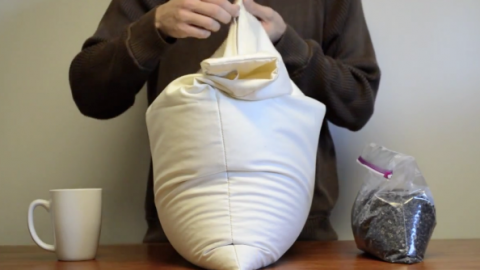
Step 2: Open the zipper and carefully scoop hulls into a storage bag.
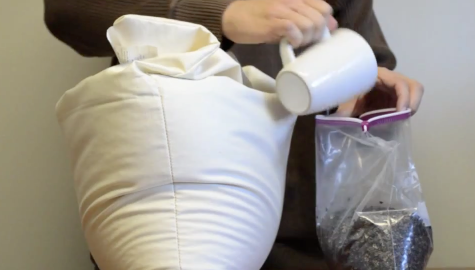
Step 3: After every ½ gallon close the zipper, and plump the pillow filling with your hands testing for the desired thickness. The amount of pillow filling determines the thickness of your pillow. Adjust the filling to personal preference or to accommodate your sleeping position.
Buckwheat pillows are a great pillow for neck pain. In order to maintain proper spinal alignment while sleeping and avoid neck pain, side sleepers will generally have a more full pillow and may only need to remove up to 1 gallon, if any hulls. Back sleepers vary and stomach sleepers may need to remove 2-5 gallons of buckwheat hulls from their pillow.
